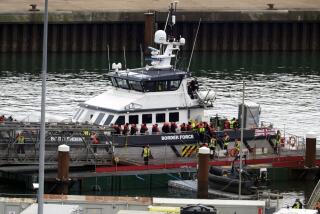Suez âWarâ: How Egypt Torpedoed Britain, France, Israel and Took Canal
ISMAILIYA, Egypt--Col. Mahmoud Younis, leader of 30 men who had just changed the worldâs political map, spent the night of July 26, 1956, asleep in his underwear on the floor of his new office.
As he slept, politicians and generals abroad huddled to assess what many of them deemed an outrage.
On the order of President Gamal Abdel Nasser, Younis and his team had carried out Egyptâs nationalization of the Suez Canal, wresting control from the British and French.
For the first time since it was built (1859-1869) by the French engineer Ferdinand de Lesseps, the 100-mile waterway was now wholly in the hands of Egypt.
Britain became the largest shareholder in the canal in 1875, purchasing its interest from the Egyptian khedive. The Convention of Constantinople signed by the major European powers in 1888 declared the canal a neutral waterway to remain open to all nations in time of peace or war. Britain became the guarantor of the canalâs neutrality and management was left to the Paris-based Suez Canal Co.
After nationalization, a broad consensus in the West was that the Egyptians were incapable of running such a vital waterway and that Nasser could not be trusted to keep it open for free passage.
Chief among the skeptics was Sir Anthony Eden, the British prime minister, who told his colleagues: âThe Egyptian has his thumb on our windpipe.â
Early on the morning of July 27, Eden urged President Dwight D. Eisenhower to commit the United States to the fight to remove the thumb.
âApart from the Egyptiansâ complete lack of technical qualifications,â Eden cabled the President, âtheir past behavior gives no confidence that they can be trusted to manage it with any sense of international obligation.â
But Eisenhower held back. Eden, already incensed over Nasserâs Arab nationalist views, was forced to turn to France and Israel for the military operation that the Egyptians still call the Tripartite Aggression.
The adventure ended in disgrace for Britain and France, when both the United States and the Soviet Union voted for a United Nations resolution demanding withdrawal.
Many historians agree that the Suez crisis brought an end to Edenâs political career, to Britainâs role as a world policeman east of Suez, and to the downfall two years later of Franceâs Fourth Republic.
But 30 years after nationalization, the Suez Canal works efficiently.
Even during a recession in shipping caused by the global oil glut, the âbig ditchâ is pumping around $900 million a year into Egyptâs ailing economy, averaging 65 passages a day.
Operation Flawless
In May, the worldâs largest merchant ship, the 555,000-ton Greek-owned Hellas Fos, steamed in ballast through the canal for the first time. Capt. Aly Nasr, the canalâs deputy director of transit, said the operation was so flawless that the owners have promised regular passages.
Plans are under way to send through a huge self-propelled Norwegian oil exploration rig in the fall, the first transit for such a vessel, which will bring in roughly $650,000, a record for a single transit.
In 1955, the last full year of operation by the Suez Canal Co., 108 million tons of oil and general cargo transited the canal. The figure for 1983, the last year before oil shipments declined due to the oil glut, was 378 million tons, and the current pace remains around 370 million tons. The increase is due largely to a $1.2-billion canal-improvement project that lets it handle all but the largest supertankers.
A large part of the waterwayâs success is credited to Egyptâs Suez Canal Authority. It is autonomous and unburdened by the bureaucracy and obstacles facing other public institutions in Egypt.
The Egyptians say the canal was in bad shape when Younisâ team took it over and he became the first chairman of the Suez Canal Authority.
The French companyâs 99-year concession was to have expired in 12 years, but Nasr said a recent interview that the canal was âdecaying one year after the other, so that at the time they were going to give it to the (Egyptian) government it would be a wreck.â
He said Younis began thinking immediately of expanding the canalâs services and income.
The canal authority saw the approaching supertanker market in 1966, decided on the need to refurbish the canal and began work on Feb. 22, 1967. But on June 5, the Six-Day War between the Arabs and Israelis broke out, and the wreckage of war forced the closing of the canal. The Israelis were in control of its eastern bank.
A U.S.-sponsored troop-disengagement agreement restored the canal to Egyptian operation in 1974, and a mainly U.S.-British salvage team spent the next 18 months clearing its channels of sunken vessels and other debris of the war.
The canal authority immediately went to work, promising to complete an improvement project in 1980.
On Dec. 16, 1980, it was done, almost exactly on budget. Previously restricted to ships of 60,000 tons loaded, the canal now could accommodate supertankers of up to 150,000 tons loaded and 370,000 tons in ballast.
In 1981, 57 ships of more than 300,000 tons went through.
Nasr, the deputy transit director who was a member of Younisâ 1956 task force, said he has no doubt that a large part of Egyptâs success with the canal springs from Younis himself.
âHe was pushing us and giving us a very good spirit to give as much as possible for our country.â
Younisâ reputation as a top-flight army engineer had led to his selection by Nasser as the architect of the takeover plan.
Nasser decided to nationalize the canal after U.S. Secretary of State John Foster Dulles on July 20, 1956, reneged on a promise to lend Egypt $70 million to help build the Aswan High Dam across the Nile River in southern Egypt--a dream of Nasserâs.
Summoned by Nasser, Younis devised a minute-by-minute plan that would take over canal installations at Ismailiya, Port Said on the Mediterranean and Suez City at the canalâs southern end, as well as its Cairo offices.
His plan envisioned no violence or coercion.
The administrative offices would be closed at the time, but the foreign and Egyptian technicians would be told that operations must continue normally with one exception: communications with Paris would cease immediately.
Not even the officers under Younisâ command, including a few senior to him, knew what they were about to do until they began.
Elaborate Scheme
After an elaborate scheme that got the 30 men to Ismailiya undetected, Younis split them into groups of 10. He kept charge of the Ismailiya segment, and he gave the groups going to Port Said and Suez City packets of envelopes that he said must guide their actions.
The final envelope, to be opened at a prearranged signal, contained details of what each group was to do.
The signal to move was to come from Nasser in a speech broadcast nationwide from Alexandria: The men were to move when he said âFerdinand de Lesseps,â the canalâs builder.
The plan worked flawlessly, and Younis later said he heard on the radio as he took over the headquarters office in Ismailiya the last words of Nasserâs speech:
âNow, while I am talking to you, brothers of yours, sons of Egypt, are rising up to direct the canal company and undertake its operation. Now, at this moment, they are taking over the canal company--the Egyptian canal company. Not the foreign canal company.â
After receiving reports from the other officers involved in the takeover, Younis said, he stretched out on the floor and slept well.
More to Read
Sign up for Essential California
The most important California stories and recommendations in your inbox every morning.
You may occasionally receive promotional content from the Los Angeles Times.










